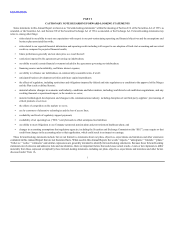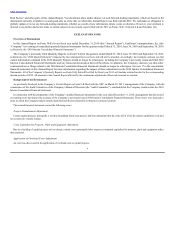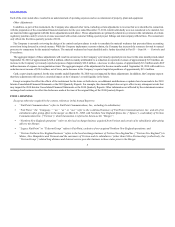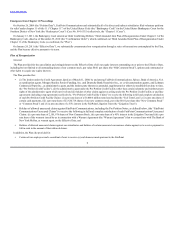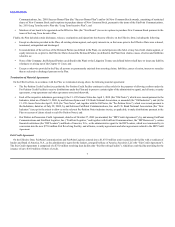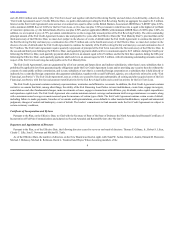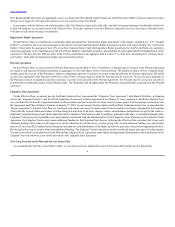FairPoint Communications 2010 Annual Report Download - page 14
Download and view the complete annual report
Please find page 14 of the 2010 FairPoint Communications annual report below. You can navigate through the pages in the report by either clicking on the pages listed below, or by using the keyword search tool below to find specific information within the annual report.
Table of Contents
We are subject to regulation primarily by federal and state governmental agencies. At the federal level, the Federal Communications Commission (the
“FCC”) generally exercises jurisdiction over the facilities and services of communications common carriers, such as FairPoint, to the extent those facilities are
used to provide, originate or terminate interstate or international communications. State regulatory commissions generally exercise jurisdiction over common
carriers’ facilities and services to the extent those facilities are used to provide, originate or terminate intrastate communications. In addition, pursuant to the
Telecommunications Act of 1996 (the “1996 Act”), which amended the Communications Act of 1934 (the “Communications Act”), state and federal
regulators share responsibility for implementing and enforcing the domestic pro-competitive policies introduced by that legislation.
Legacy FairPoint’s operations and our Northern New England operations operate under different regulatory regimes in certain respects. For example,
concerning interstate access, all of the pre-Merger regulated interstate services of FairPoint were regulated under a rate-of-return model, while all of the rate-
regulated interstate services provided by the Verizon Northern New England business were regulated under a price cap model. See “Part 1 — Item 1. Business
— Regulatory Environment” for further information regarding rate-of-return and price cap models. On May 10, 2010, we received FCC approval to convert
our Legacy FairPoint operations in Maine and Vermont to the price cap model. Our Legacy FairPoint operations in Maine and Vermont converted to price cap
regulation on July 1, 2010. We have obtained permission to continue to operate our existing Legacy FairPoint incumbent local exchange carriers (“ILECs”)
outside of Maine and Vermont under the rate-of-return regime until the FCC completes its general review of whether to modify or eliminate the “all-or-nothing”
rule. Without this permission, the all-or-nothing rule would require that all of our regulated operations be operated under the price cap model for federal
regulatory purposes. In addition, while all of our operations generally are subject to obligations that apply to all local exchange carriers (“LECs”), our non-rural
operations are subject to additional requirements concerning interconnection, non-discriminatory network access for competitive communications providers
and other matters, subject to substantial oversight by state regulatory commissions. In addition, the FCC has ruled that our Northern New England operations
must comply with the regulations applicable to the Bell Operating Companies. Our rural and non-rural operations are also subject to different regimes
concerning universal service.
We offer a broad portfolio of high-quality communications services for residential and business customers in each of the markets in which we operate. We
have a long history of operating in our markets and have a recognized identity within each of our service areas. Our operating companies are locally staffed,
which enables us to efficiently and reliably provide an array of communications services to meet our customer needs. These include services traditionally
associated with local telephone companies, as well as other services such as Internet, television and broadband enabled services. Based on our understanding
of our local customers’ needs, we have attempted to be proactive by offering bundled services designed to simplify the customer’s purchasing and management
process.
We primarily generate revenue through: (i) the provision of our basic local telephone service to customers within our service areas; (ii) the provision of
network access to interexchange carriers for origination and termination of interstate and intrastate long-distance phone calls and dedicated private line
facilities; (iii) HSD services; (iv) Universal Service Fund high-cost loop and high-cost model payments; and (v) the provision of other services such as long-
distance resale, other data and Internet and broadband enabled services, enhanced services, such as caller name and number identification, and billing and
collection for interexchange carriers.
See “Item 7. Management’s Discussion and Analysis of Financial Condition and Results of Operations” in this Annual Report for more information
regarding our revenue sources.
13


